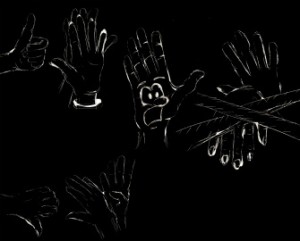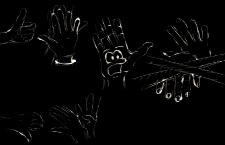Certain things have always been open secrets on this campus: how “off-and-away” doesn’t always mean off-and-away, how the “discretionary” dress code really isn’t, and what really happens at the annual Welcome Back Dance. Frivolous as these examples may be, they indicate at a much bigger issue at this school—the vast difference that exists between the letter of the law and the administration of the law.
Students have to look no further than the school dances issue to see where policy and enforcement diverge. Take, for example, the “Student Relationships” section on page 15 of the Student Handbook. It states, in no uncertain terms, that “physical contact should be limited to holding hands or sitting next to each other.” Yet, members of administration, only weeks earlier, had demonstrated the various exceptions to the no “physical contact” rule. Through a series of abstract and perplexing hand motions, members of administration attempted to clarify and define the bounds of what appropriate touching and dancing looks like during, ironically, a zero tolerance presentation.
There is a lack of clarity not because of a lack of written regulation. Written regulation does exist. It, just like the no ”sexually suggestive dance moves” rule, fails to reflect the evolving expectations of student behaviors.
To break it down: face-to-face-with-a-little-bit-of-space is and has always been okay. The trouble and the confusion lies in the front-to-back area. For the first time ever, administration has come out to verbalize what a significant portion of the student body has been waiting to hear: front to back dancing, or better known as “freaking,” is finally okay.
Rather th an resolving the issue, this concession has made the line between what is acceptable and what is not murkier than ever. To take administrationís own analogy, “freaking” is like driving above the speed limit. At a speed limit of 65 mph, driving at 70 mph won’t warrant an arrest, but driving at 85 might. Similarly, with the “freaking” policy of both-partners-90-degrees-from-the-ground as the “speed limit”, dancing at 80 degrees might not get you kicked out of the dance, but dancing at 40 might.
an resolving the issue, this concession has made the line between what is acceptable and what is not murkier than ever. To take administrationís own analogy, “freaking” is like driving above the speed limit. At a speed limit of 65 mph, driving at 70 mph won’t warrant an arrest, but driving at 85 might. Similarly, with the “freaking” policy of both-partners-90-degrees-from-the-ground as the “speed limit”, dancing at 80 degrees might not get you kicked out of the dance, but dancing at 40 might.
But that still leaves a question: what about the rest of us who are simply driving at the speed of traffic? Could this not quite radical, but nonetheless forward-leaning group, be the so-called silent majority that is quietly but persistently transforming administrative policy?
If this is indeed the tide of school culture turning, then one can’t help but wonder if this shift towards lenient policy-making is here to stay. There remains the issue that, for all intents and purposes, no actual MVHS policy has changed. What has changed is administration’s now-lax interpretation and enforcement of rules involving student conduct. Like the off-and-away policy that is subject to individual teacher discretion and the dress code that no one seems to have read, the gray area surrounding dances has widened to the point of obstructing any real meaning.
The question of why leads to a rather murky and uncomfortable idea: could the vagueness and archaic attitudes of the policies be intentional? Could it be that we, as a student body, want a degree of freedom that we cannot verbalize? Perhaps, despite the fact that “freaking” is begrudgingly tolerated by the administration, there is a certain shame in admitting—on paper, for the world to see—that we are a body of people who grind and freak even as we cram and stress.
And when it comes down to it, no one—student or administration—wants to be on the receiving end of a parent inquiry as to why her daughter is “freak dancing” up against someone else’s son.
The dilemma regarding how much to legislate on paper is a real one, but the bottom line is this: we canít have our cake and eat it too. Administration, in conjunction with the student body, has a choice to make, and so far, they have not chosen. What has been done is the bending and twisting of existing rules. Yet, that gives way to an unshakable sense of hypocrisy as the student body pledges to one code of behavior and lives by another. This discord only highlights how vital it is for our schoolís cultural and social identity that we align the letter and the spirit of the law.
Wherever the alignment falls, there are trade-offs to be made. The inevitable tug-of-war between the rules as they are written and the rules as they are enforced will compel the student body and the administration to finally decide where our collective values lie. If they happen to encompass an embarrassingly detailed ìfreakingî policy, then so be it, but the issue is much bigger than ìfreakingî. It is about committing to a single standard of conduct across the student body and eliminating the gray area. Because, really, it is time for some clarity. Once that is gone, not even all the complex hand gestures in the world can bring that clarity back.





